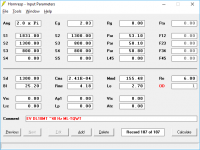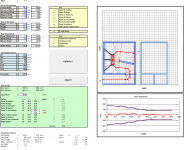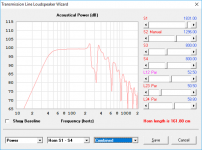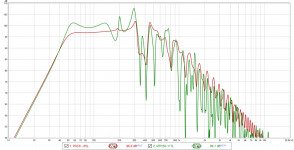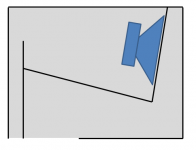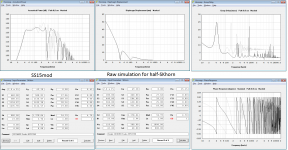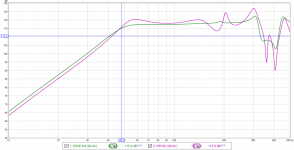I have a possible design, but you're not going to get to 300 Hz with it. More like 150 Hz.
Hmm, why doesn't my sim look like yours ?
 I used these specs: https://www.electrovoice.com/binary/DL18MT_Woofer_EDS.pdf
I used these specs: https://www.electrovoice.com/binary/DL18MT_Woofer_EDS.pdfGM
Attachments
Hmm, why doesn't my sim look like yours ?I used these specs: https://www.electrovoice.com/binary/DL18MT_Woofer_EDS.pdf
GM
Driver specs look slightly different. I let Hornresp calculate them from Vas, Fs, Qes, Qms, Qts and Sd.
Attachments
OK. I think the scaled up POC3 is about 21" W 23" D 28" H. Old carpenter in over his head here. Am I anywhere near the ball park?
Not quite. The layout is a bit different, and I think it probably needs to be refined a bit more. Here's a version that assumes light stuffing between S1 and S2 (i.e. from the top of the enclosure to just short of the driver. Basically stuff until Fb hits 39 Hz. The box should be useful to 150 Hz, if you roll it off steeply above that. The workbook does not show all of the bracing required - at the very least I'd consider bracing the top of the enclosure.
Anyway, use at your own peril
Attachments
Not quite. The layout is a bit different, and I think it probably needs to be refined a bit more. Here's a version that assumes light stuffing between S1 and S2 (i.e. from the top of the enclosure to just short of the driver. Basically stuff until Fb hits 39 Hz. The box should be useful to 150 Hz, if you roll it off steeply above that. The workbook does not show all of the bracing required - at the very least I'd consider bracing the top of the enclosure.
Anyway, use at your own peril
Hello Brian,
Maybe I over looked it, but does the spreadsheet take into account, for the drivers occupied volume at S2?
Hello Brian,
Maybe I over looked it, but does the spreadsheet take into account, for the drivers occupied volume at S2?
No, it does not, but that volume is usually very small compared to the size of the box anyway.
Wow, amazing build. So small. I built myself 2 tham15 this summer, and I am planning for a more compact build. So I just came over this design, and it really looks promising. Could you possibly elaborate a bit about this design in comparison to the cubo12 and the mth30?
I've heard about those two designs, but I'll need to see *accurate* Hornresp sims for both to see how they likely compare. I suspect however that, based on what I'm seeing, their lower cutoff points are similar to my POC6, but they are a few dB more efficient, the box sizes look a bit larger, and the usable bandwidth is narrower.
Here's a comparison between the POC6 and an MTH30 layout that's "optimized" for the PA310. The MTH30 will be almost 3dB more sensitive, but the box is almost twice the volume, and the usable bandwidth is less than that of the POC6.
Attachments
Hi Brian,
I just started to play around with half-SKhorn design and it looks very interesting, in terms of frequency response I reached very close to TH but less spike in the upper range. This design is much more friendly to build, in addition, the pressure on the cone was slightly lower what helps drivers with lightweight cones. I will start an sketch on solidworks to improve the comparison properly.
Once you are very fast with excell workbook, do you mind to compare also this design (half-skhorn) using the PA310 versus the POC6 and the MTH30?
looks like the lower response comes from vented rear chamber, so the front horn don't need to be long as TH. The result is intriguing me if i could get the the similar response from TH but also with lower volume. The diaphragm displacement was also the similar for the same voltage input.
I just started to play around with half-SKhorn design and it looks very interesting, in terms of frequency response I reached very close to TH but less spike in the upper range. This design is much more friendly to build, in addition, the pressure on the cone was slightly lower what helps drivers with lightweight cones. I will start an sketch on solidworks to improve the comparison properly.
Once you are very fast with excell workbook, do you mind to compare also this design (half-skhorn) using the PA310 versus the POC6 and the MTH30?
looks like the lower response comes from vented rear chamber, so the front horn don't need to be long as TH. The result is intriguing me if i could get the the similar response from TH but also with lower volume. The diaphragm displacement was also the similar for the same voltage input.
Attachments
Here's a better comparison, this time with a more optimized MTH30 fold using the PA310 driver. It has the same resonance frequency as the POC6, and both are driven with enough voltage to reach the driver's 5mm Xmax in the passband. This shows that the PO6 does approach the peak output of the MTH30 quite closely, but needs a bit more voltage to do so.
Attachments
Could you possibly elaborate a bit about this design in comparison to the cubo12 and the mth30?
I had a closer look at the Cubo 12 info available on the 'net. While there have been some attempts to sim it in Hornresp, the sims don't look accurate. According to the illustrated layout, the Cubo 12 should be simmed as a "butterfly" shaped TH with parabolic segments, with a "pinch" between S3 and S4. However Hornresp does offer enough segments to simulate this type of layout. It needs at least one extra segment to emulate that pinch.
Thank you so much! So POC6 seems to be a better fit for me than the mth30. That little difference in sensitivity does not justify twice the size for a compact build. But the cubo12 seems interesting with only 97 liters, still super compact. I'm not efficient enough with hornresp yet to do something like that, is it lot of work? Is it something you could be interested in helping out with?
Thank you so much! So POC6 seems to be a better fit for me than the mth30. That little difference in sensitivity does not justify twice the size for a compact build. But the cubo12 seems interesting with only 97 liters, still super compact. I'm not efficient enough with hornresp yet to do something like that, is it lot of work? Is it something you could be interested in helping out with?
The Cubo 12 is 97L. The optimized MTH30 is 117L, 21% larger than the Cubo 12. The POC6 is 65 L, so the Cubo 12 is 49% bigger and the MTH30 is 80% bigger. I think some of the claims for the Cubo 12 seem a bit optimistic and, as I mentioned before, it can't really be accurately modeled using Hornresp. If I was already going for a bigger enclosure, I'd probably opt for an optimized MTH30 instead.
- Status
- This old topic is closed. If you want to reopen this topic, contact a moderator using the "Report Post" button.
- Home
- Loudspeakers
- Subwoofers
- Simple bass unit using the Dayton PA310
